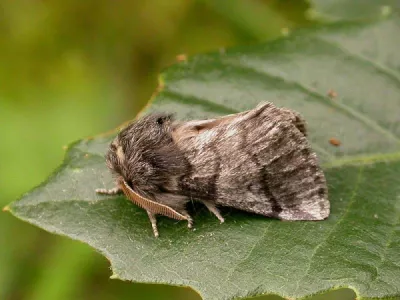Oak processionary moth
Do you have a oak processionary moth problem?

Home
>
Oak processionary moth
Oak processionary moth - (Thaumetopoea processionea)
The oak processionary is a moth whose caterpillars can be found in oak forests, where they feed on oak leaves, causing significant damage. They travel in nose-to-tail processions, often arrow-headed, with a leader followed by rows of several caterpillars abreast

Signs of a OPM infestation
What to look for...
- The Caterpillars: They are dark (grey/black) with a lighter stripe down the back, covered in both long white hairs and thousands of microscopic, irritating barbed hairs. They move in distinctive nose-to-tail processions on the trunk and branches, typically from May to July.
- The Nests: White silken web-like nests found almost exclusively on the trunks and large branches of oak trees (not among the leaves or on walls/fences). They quickly become discoloured and brown.
- Tree Damage:Skeletonised oak leaves (where only the main veins remain) or significant defoliation (loss of leaves).
Where to look...
- Oak Trees: The caterpillars and their nests are found almost exclusively on oak trees (Quercus species).
- Trunks and Branches: Nests are built on the trunks and larger branches of the oak tree, ranging from ground level up to the canopy.
- On the Ground: Look for dislodged nests and stray caterpillars, as the irritating hairs can remain on the grass and soil beneath an infested tree for a long time.
OPM prevention and control
Prevention & safety
- Do Not Touch or Approach: Never touch or go near the caterpillars or their nests—not even old, empty nests—and ensure children and pets are kept well away. The irritating hairs remain hazardous long after the caterpillars are gone.
- Report Sightings: Report any suspected sightings on a tree you do not own to the relevant authority (e.g., the Forestry Commission) to assist with monitoring and control efforts.
- Avoid High-Risk Areas: During the main risk period (May to July), avoid spending prolonged time under or downwind of infested oak trees.
- Keep Pets Restrained: In affected areas, keep dogs under control, such as on a lead, to prevent them from investigating nests or caterpillars on the ground.
Control
- Professional Intervention Only: Do not attempt to deal with or remove nests yourself. Only trained professional contractors wearing appropriate protective equipment should carry out control measures.
- Targeted Pesticide Application: The most effective time for professional pesticide control is in the spring (around April-May), when the caterpillars are young and before they have fully developed their hazardous hairs.
- Nest Removal: Professionals use specialized vacuum equipment or manual removal to destroy nests. This is often best carried out after the caterpillars have retreated inside to pupate (late June to early August), to ensure all are destroyed.
- Pheromone Trapping: In some areas, pheromone traps are used to catch male moths, which can help monitor the population and reduce mating numbers, though this is primarily a surveillance and containment tool.